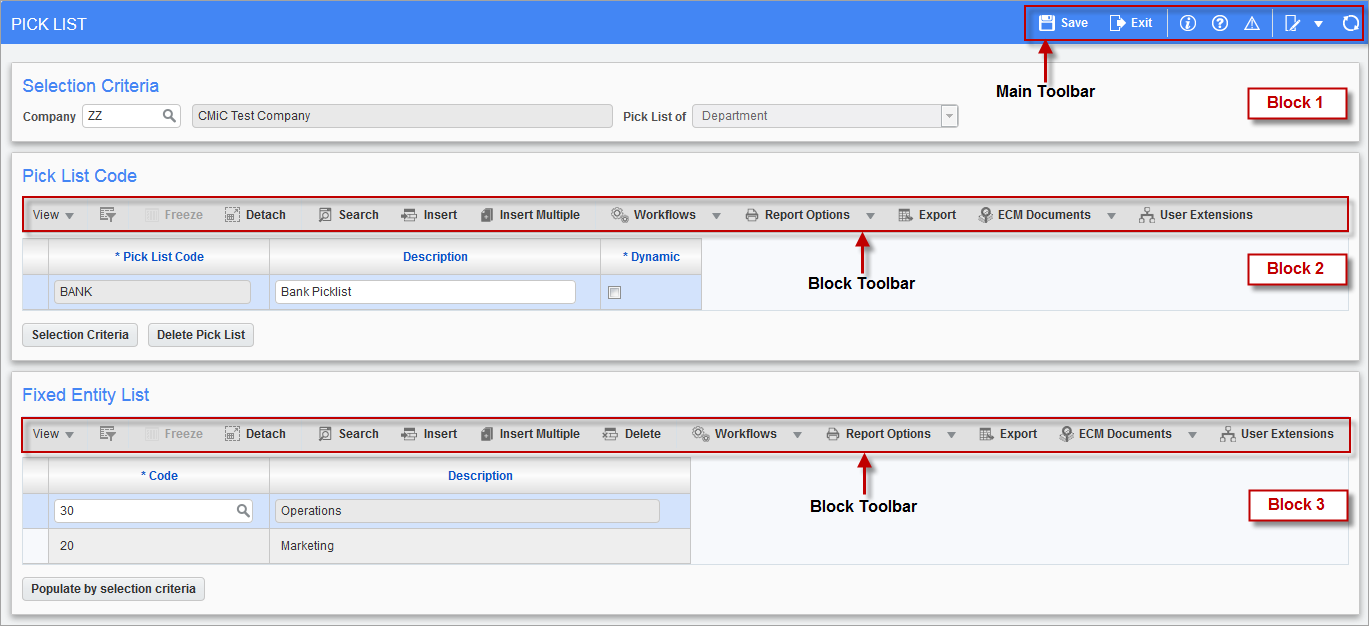
Screen with three sections and the two main toolbar types used by Enterprise Console
The screens of Enterprise Console use two main toolbar types: Main Toolbar and Block Toolbar. The Main Toolbar handles the broad functionality of the screen, and the Block Toolbar handles section-specific functionality. The options available in these toolbars can vary.
Main Toolbar Options

About – Current Application

The About icon, on the Menu Toolbar, displays information about the current module and the editing privileges of its current user. For more details, see Getting Started - About.
Main Toolbar Icons
| Icon | Name | Usage | Function Key |
|---|---|---|---|

|
Add New |
Add/Insert a new record. |
N/A |

|
Table Mode |
Switch from displaying a single record to displaying a table of records. |
N/A |

|
Save |
Save the record(s) in the current application. |
Ctrl-S |

|
Exit |
Exit the current application. |
Ctrl-Q |

|
About |
Displays information about the current application and the editing privileges of its current user. |
N/A |

|
Help |
Launches the Help screen for the current application in a new browser window. Refer to the ADF Help section of this guide for further details. | N/A |

|
Error Details |
Displays details about any errors that may have been encountered in the current application. |
N/A |

|
Toggle Edit Mode |
Used to customize the application’s display for a user. After clicking this option, click any of the Pencil icons to bring up the customization screen. The screen will display up to 3 tabs: Fields, Tabs, and Table Mode. Then customize how the application displays its records, such as what fields or tabs to display, and whether the module should start in table mode or form mode. NOTE: Module must be in form mode to customize the tabs. |
N/A |

|
Restart |
Restarts the current application. | N/A |
Block Toolbar Options
This section provides further details about the more involved options of the Block Toolbar.
Attachments and Notes

Job Setup screen in form mode, displaying a record with associated attachments and notes

Screen in table mode, displaying a record with associated attachments and notes
Attachments and notes enable the storing of additional information related to Enterprise objects, such as projects, jobs, contract forecasts, and work items. Attachments can be any type of file format (XLS, CSV, DOC, PDF, etc.), and require an appropriate module to open and view them. Notes, in comparison, are like post-it notes, and their text is displayed by their Enterprise module.
Screens displaying records that can have associated notes or attachments, or both, have the [Notes] or [Attachments] button on the Block Toolbar. Also, if a record has any associated notes or attachments, the [Notes] or [Attachments] buttons will display how many, within brackets, as shown by the above screenshots.
Notes
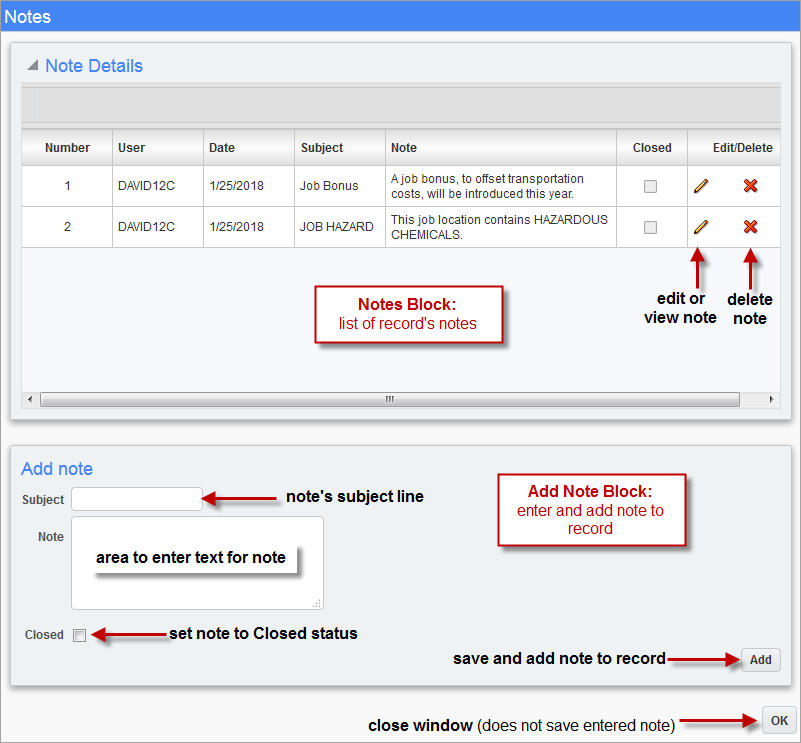
The above screenshot shows the Notes pop-up window that is displayed when the [Notes] button is clicked. In the Note Details section, the fields displayed for each note are for display only.
The Closed field indicates if the note’s status is closed or open. The closed status can have different meanings for different companies. One meaning, for instance, is that the note is no longer current.
To edit or view a note, click the corresponding Pencil icon. To permanently delete a note, click the corresponding Delete Icon (X).
Notes are added using the Add Note section. Enter the note’s subject line (if enabled in System Options), and enter the note into the note’s text area. The ‘Closed’ checkbox is available if the note’s entry is belated and no longer current, but could still be helpful. Once the note’s information has been entered, click the [Add] button to save and add the note. The note will be displayed in the Note Details section.
Click the [OK] button to close the window, but note, this will not save the note. To save the note, the [Add] button must be used.
NOTE: The subject line for notes is optional. It will appear, system wide, if it is enabled by the checkbox, ‘Subject Line Appears In Notes Entry’. The checkbox is found on the General tab of the System Options screen (System > Setup > System Options).
Attachments

The screenshot above shows the Attachments pop-up window that is launched when the [Attachments] button is clicked. This pop-up window is comprised of two sections.
Attached Files – Section
The list of attached files can be collapsed or expanded using the  and
and  icons, respectively.
icons, respectively.
To view an attached file, simply click the file’s name (file names are hyperlinks).
To delete an attachment, click on its corresponding Delete icon (X).
Upload – Section
To upload an attachment, there are two options:
Upload Option 1
Use the [Browse] button to bring up a File Manager window to search for and select the file to upload.
Upload Option 2
If you have a File Manager window already open, you can use the drag-and-drop method to attach the file by clicking and holding the mouse button on the file to attach, and then dragging it over to the drop area in the Attachments window, as shown in the below screenshot.
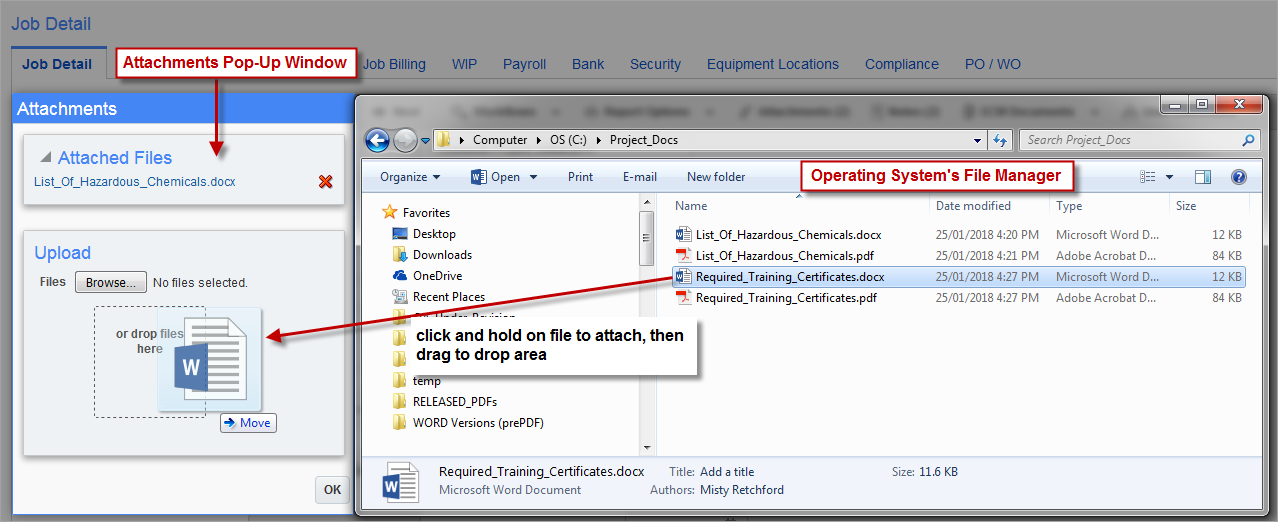
For both methods, once the green upload status bar is full, showing that the upload has finished, click okay to complete the attachment.
NOTE: Adding attachments to ADF screens which have this functionality available requires additional security privileges to be assigned to a user's PM role in CMiC Field. The
ECM Documents
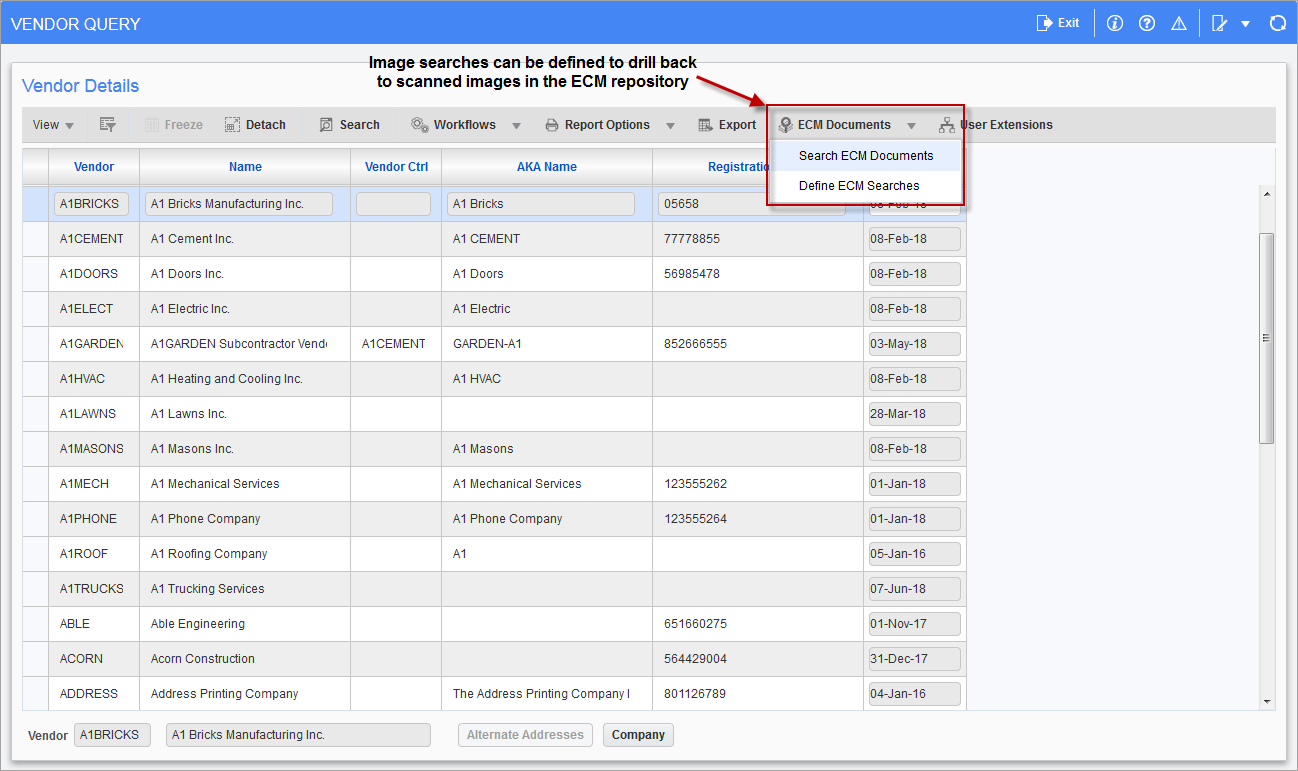
[ECM Documents] button on the Block Toolbar
Any program within CMiC Enterprise can be given the ability to query and display images according to the current data record. Each program can have multiple searches defined.
Searches are user-defined, allowing for maximum flexibility and customization.
When the user is in a particular screen, for example the AP Vendor Query, they can, if at least one image search has been defined, view the images with a relationship to the current record.
Define ECM Search
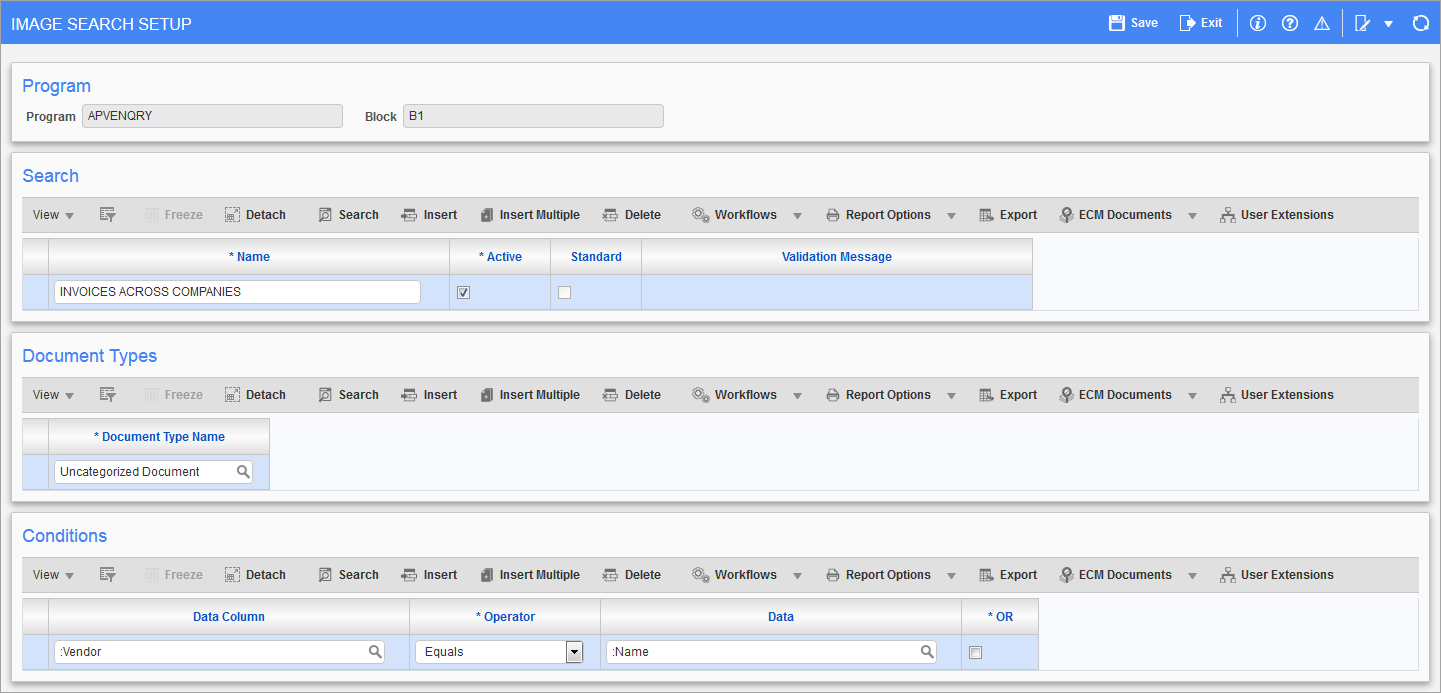
Image Search Setup pop-up window launched from the drop-down menu in the [ECM Documents] button
Defining a search is done directly in the CMiC Enterprise screen that requires the search to be added. To define the search, click on the drop-down menu of the [ECM Documents] button and select “Define ECM Searches”.
The Image Search Setup screen is used to define/create the image searches required for the program. The system allows for more than one image search per program.
This facility has been designed to be as simple to use as possible, but it still requires that the user be familiar with table joins, functional operators plus, and/or statements.
Search ECM Documents
The following screenshot is an example of the results of an image search showing scanned images in CMIC’s ECM repository.
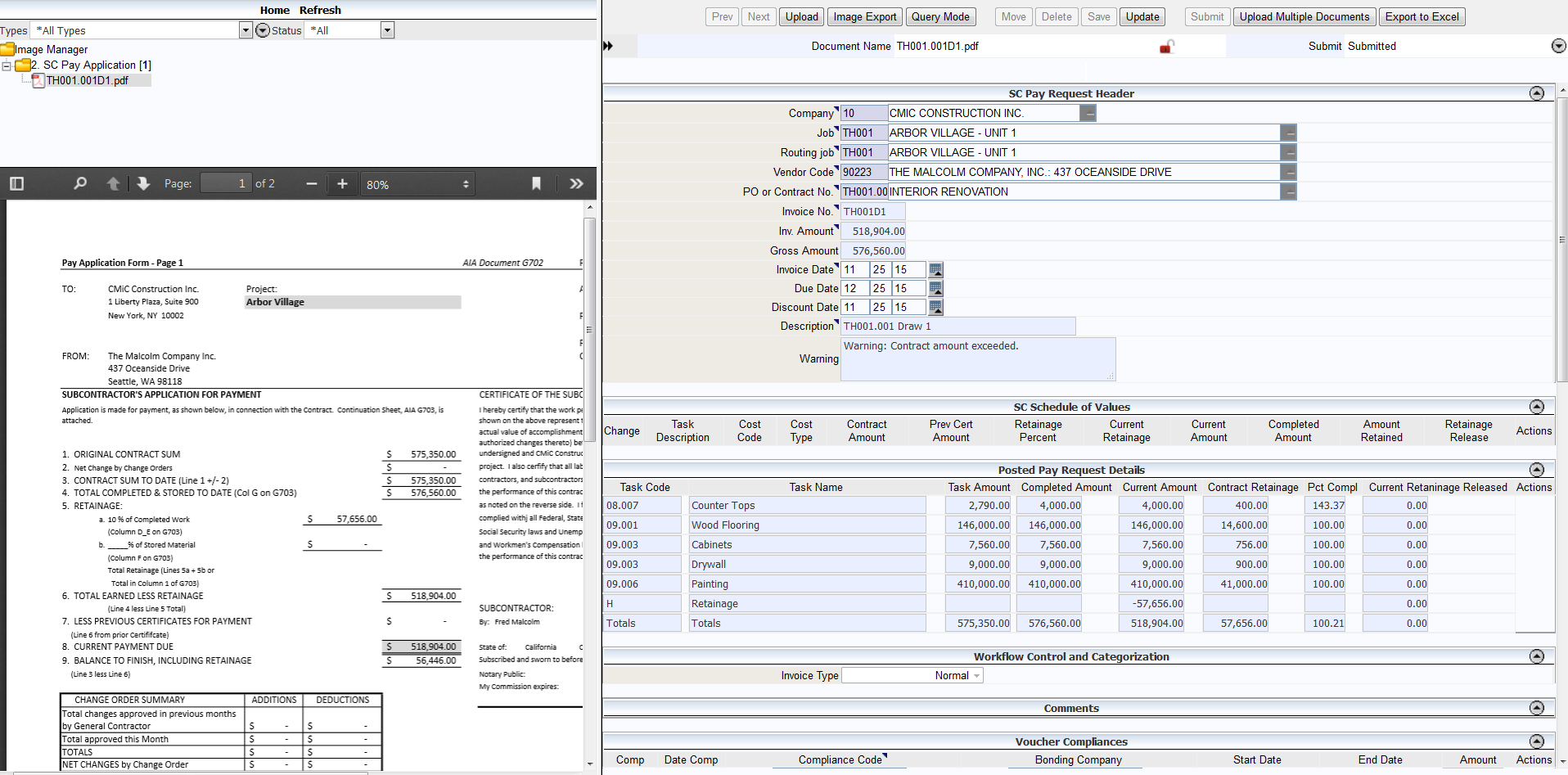
Search results in CMIC’s ECM repository
Block Toolbar Icons
| Icon | Name | Usage |
|---|---|---|

|
View |
Control how records are displayed in a table, such as how they are sorted, how the columns are ordered, and what columns are displayed. Refer to the Searches, Table Filters & Sorts section of this guide for further details. |

|
Query by Example (Filter) |
Available in table mode and used to filter the records displayed by the table. Refer to the Searches, Table Filters & Sorts section of this guide for further details. |

|
Freeze |
Prevent current record from being altered. |

|
Detach |
Detach the corresponding screen or block from the console. |

|
Search |
Similar to the Query by Example button, but has more options. Used to find and display a record or a group of records. When activated, a filter (search) section will appear with key fields that correspond to the fields of the records handled by the current screen. Enter the value or text in the field(s) that you want to match records against and press the [Go] button. Refer to the Searches, Table Filters & Sorts section of this guide for further details. |

|
Insert Record |
Create a new record for data entry and insertion into the system. |

|
Insert Multiple Records |
Bring up a table of new, empty records for data entry and insertion into the system. |

|
Delete Record |
Delete selected record from the system. |

|
Previous Record |
When in form mode (displaying a single record), this option displays the record that is before the current record. |

|
Next Record |
When in form mode (displaying a single record), this option displays the record after the current record. |

|
Workflows |
Deals with the workflows defined for the current application, block and row. Please refer to the Workflow reference guide for further details. |

|
Report Options |
Used to set up and print reports for the screen or block. |

|
Export |
Creates an Excel/XLS file of the records handled by the current screen. |

|
Import |
Used to import records into the system through an Excel/XLS file. |

|
Attachments |
Add or view attachments associated with the current record. Refer to the Block Toolbar Options section for further details. |

|
Notes |
Add or view notes associated with the current record. Refer to the Block Toolbar Options section for further details. |

|
ECM Documents |
Enterprise Content Management |

|
User Extensions |
Display user extensions, which are custom fields that have been added to the records handled by the current screen. Refer to the User Extension section of the System Data reference guide for further details. |